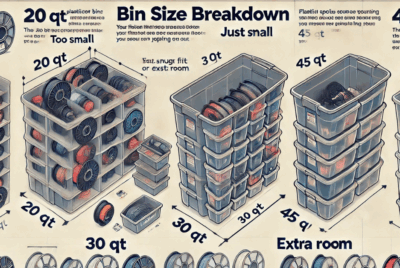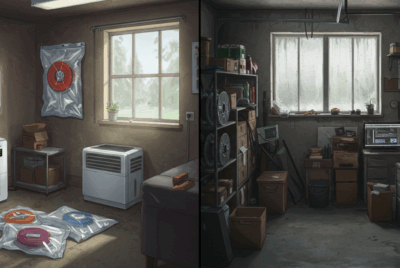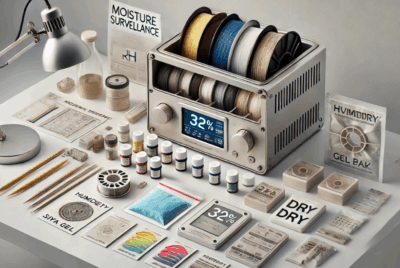What Are the Key Differences Between Vacuum-Sealing and Using a Filament Dry Box for Moisture Protection?
When it comes to moisture protection for 3D filament, vacuum-sealing and filament dry boxes are two of the most commonly used storage methods. While both aim to keep filament dry and in optimal condition for printing, they have distinct advantages and limitations. Here’s a comparison of the key differences between vacuum-sealing and using a filament dry box for moisture protection.
1. Method of Moisture Protection
- Vacuum-Sealing:
- How It Works: Vacuum-sealing involves removing air from a vacuum bag to create an airtight environment. This process not only removes moisture from the bag but also significantly reduces exposure to air, which helps prevent filament degradation.
- Why It Works for Moisture Protection: By removing air, vacuum-sealing minimizes the amount of moisture that can come into contact with the filament. Additionally, when combined with desiccants (moisture-absorbing agents), vacuum-sealing helps keep the filament dry for long-term storage.
- Limitations: Although vacuum-sealing is effective at preventing moisture from entering the bag, once the bag is opened, the filament is exposed to the air, and moisture can begin to re-enter unless the bag is resealed properly.
- Filament Dry Box:
- How It Works: A filament dry box is a sealed container that typically features humidity control, often through the use of desiccants or a built-in drying system. Some dry boxes include features like humidity monitors and heating elements to maintain a constant, low humidity level.
- Why It Works for Moisture Protection: Dry boxes are designed to maintain a consistent moisture-free environment by either absorbing moisture with desiccants or actively circulating warm, dry air. This creates an environment where the filament can be stored safely without exposure to external moisture.
- Limitations: Dry boxes are typically more expensive than vacuum-sealing setups, and they require continuous power (for models with active drying systems) or the replacement of desiccants over time.
2. Ease of Access and Convenience
- Vacuum-Sealing:
- How It Works: After sealing the filament in a vacuum-sealed bag, the bag must be opened each time you want to use the filament, which requires resealing after every use.
- Why It Matters: The need to reseal the bag after each use can be time-consuming and inconvenient, especially if you need to access filament frequently or switch between multiple filament types.
- Limitations: This process may be less convenient if you need easy, constant access to filament, as each time you open the bag, you risk exposing the filament to air and moisture.
- Filament Dry Box:
- How It Works: A dry box allows you to keep the filament inside the box and use it without needing to open and reseal the container constantly. Many dry boxes have spool holders that allow you to pull filament directly into your 3D printer.
- Why It Matters: Dry boxes are more convenient for active use because you can keep the filament inside the box and print without needing to frequently open or reseal the container. The filament remains protected from moisture, and you don’t have to worry about resealing it after every use.
- Limitations: Some dry boxes can be bulky and may take up more space than vacuum-sealed bags, especially when storing multiple spools.
3. Long-Term vs. Short-Term Storage
- Vacuum-Sealing:
- How It Works: Vacuum-sealing is ideal for long-term storage of filament. By removing air and moisture, it helps preserve filament for months or even years, as long as the bag remains properly sealed and stored in a dry environment.
- Why It’s Effective: The airtight seal creates an environment that limits the exposure of filament to moisture and air, which can cause it to degrade over time. This makes vacuum-sealing especially useful for keeping filament in long-term storage when you don’t need immediate access.
- Limitations: When you need to print with the filament, you have to open the bag and reseal it afterward, which can be inconvenient for frequent use.
- Filament Dry Box:
- How It Works: A filament dry box is effective for both long-term and short-term storage, but it shines when used for active printing. You can store filament for extended periods in a dry box without worrying about moisture, while still having immediate access to the filament for printing.
- Why It’s Effective: Dry boxes allow for continuous protection and easy access to filament, making them ideal for ongoing use. The box can maintain a consistent low humidity while you print, ensuring that the filament doesn’t absorb moisture during the process.
- Limitations: For long-term storage, a dry box may be less space-efficient than vacuum-sealing and may require more maintenance, such as replacing desiccants or ensuring the drying system remains functional.
4. Cost and Maintenance
- Vacuum-Sealing:
- Cost: Vacuum-sealing is generally a low-cost option for filament storage. A basic vacuum sealer can cost around $30 to $100, and you can use the same machine for an extended period. The main ongoing costs are for vacuum bags and desiccants.
- Maintenance: Vacuum-sealers require minimal maintenance beyond cleaning the machine and replacing the bags or desiccants periodically. Desiccants should be replaced or recharged as needed.
- Benefit: Vacuum-sealing is affordable and easy to maintain, especially for large filament collections or for long-term storage.
- Filament Dry Box:
- Cost: Filament dry boxes tend to be more expensive than vacuum-sealing systems, with prices ranging from $50 to $200 or more, depending on the features and brand. Active models with heating elements and humidity control systems tend to be on the higher end of the price spectrum.
- Maintenance: Filament dry boxes with active drying systems require regular maintenance to ensure the drying function is working properly. Desiccant-based models require occasional replacement of desiccants.
- Benefit: Dry boxes are a more hands-off solution once set up, especially if you opt for a humidity-controlled dry box that actively maintains the right environment for the filament.
5. Portability
- Vacuum-Sealing:
- How It Works: Vacuum-sealing is a relatively portable method for storing filament. Once sealed, the vacuum bags are lightweight and easy to store in any location, whether in a closet, drawer, or storage bin.
- Why It Matters: If you need to move or reorganize your filament storage, vacuum-sealed bags are flexible and easy to transport.
- Limitations: While the bags are portable, the vacuum sealer machine itself can be cumbersome, especially if you need to take it with you for resealing.
- Filament Dry Box:How It Works: Dry boxes, particularly those with active drying systems, can be bulkier and less portable due to their size and the need for a power source.
- Why It Matters: Dry boxes are generally stationary and are intended for home or studio use. Their size and weight can make them less portable than vacuum-sealed bags, particularly for users with limited space.
- Limitations: Not ideal for users who need flexibility in moving their filament storage system or those who are on the go.
Summary of Key Differences Between Vacuum-Sealing and Using a Filament Dry Box:
| Factor | Vacuum-Sealing | Filament Dry Box |
|---|---|---|
| Moisture Protection | Great for long-term storage with desiccants. | Provides continuous moisture control during active use. |
| Ease of Access | Requires resealing after each use. | Provides easy access for ongoing printing. |
| Storage Duration | Ideal for long-term storage. | Suitable for both long-term and short-term storage. |
| Cost | Low-cost initial investment and maintenance. | Higher initial cost, but low ongoing costs. |
| Maintenance | Minimal maintenance, just replacement bags. | Requires maintenance of desiccants or active systems. |
| Portability | Highly portable and compact. | Less portable, especially for active models. |
| Best For | Long-term storage and filament protection. | Active use and continuous moisture control. |
Conclusion:
Both vacuum-sealing and filament dry boxes offer strong moisture protection for 3D filament, but they excel in different areas. Vacuum-sealing is ideal for long-term storage at a low cost and is portable, but it requires resealing after each use and isn’t as convenient for frequent access. Filament dry boxes, on the other hand, are best for active printing with continuous moisture control, offering easy access to filament without the need to reseal after every use. While dry boxes are more expensive and less portable, they are a better solution for ongoing, active filament use. Ultimately, the choice depends on your specific needs—whether you prioritize long-term storage or active printing.




